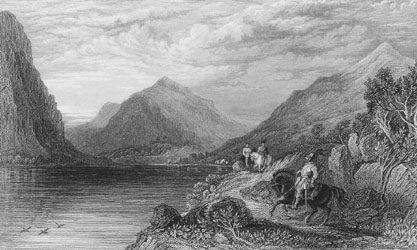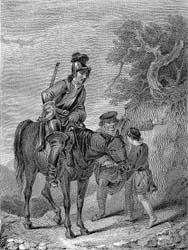|
|
Home | Corson Collection | Biography | Works | Image Collection | Recent Publications | Portraits | Correspondence | Forthcoming Events | Links | E-Texts | Contact A Legend of Montrose(Tales of My Landlord, Third Series)First Edition, First Impression: Tales of My Landlord, Third Series. Collected and Arranged by Jedediah Cleishbotham, Schoolmaster and Parish-Clerk of Gandercleugh. In Four Volumes. Vol. I (II-IV). Edinburgh: Printed for Archibald Constable and Co. Edinburgh; Longman, Hurst, Rees, Orme, and Brown, Paternoster-Row; and Hurst, Robinson, and Co. 90, Cheapside, London, 1819. Composition | Synopsis | Reception | Links Composition
The novel is set in Perthshire and Argyll. The central plot is loosely based on the murder of Lord Kilmont by James Stewart of Ardvoirlich after the battle of Tippermuir, for which Scott's principal source was John Buchanan of Cambusmore. Further sources are the memoirs of the 17th-century mercenaries Col. Robert Monro (who served during the Thirty Years' War under both Christian IV of Denmark and Gustavus Adolphus of Sweden) and Sir James Turner (who fought for both the Covenanters and the Royalists). Scott chanelled key traits and episodes from both into one of his finest comic characters, Captain Dalgetty, the soldier of fortune. In Scott's manuscript the novel is entitled A Legend of the Wars of Montrose. Neither Constable nor James Ballantyne approved the title, and Scott agreed to alter it to A Legend of Montrose despite his objection that Montrose did not himself figure prominently. The recent Edinburgh Edition of the novel (Edinburgh University Press, 1995), edited by J.H. Alexander, restores Scott's preferred title.
SynopsisThe story takes place against the backdrop of the Royalist Earl of Montrose's Highland campaign against the Covenanters in 1644. Allan M'Aulay, a member of Montrose's army, has sworn vengeance on the savage clan of Ranald MacEagh, known as the Children of the Mist, who have murdered his uncle and mistreated his mother. He is in love with Annot Lyle whom he has rescued during a foray against the clan MacEagh. Annot, however, prefers Allan's intimate friend, the Earl of Menteith, a fellow Royalist. The mystery of Annot's birth holds both back from pressing their claims. Annot has been kidnapped as a young child by MacEagh during the sacking of her father's castle, and recalls nothing of her family background. Alarmed at wild threats issued by the jealous Allan against Menteith, Montrose sends him away on a mission. When Allan finds and mortally wounds MacEagh, the old cateran confesses that Annot is the daughter of Sir Duncan Campbell, the Knight of Ardenvohr, with whom she is reunited. As she is thus revealed to be a suitable match, Annot is engaged to Menteith, and plans are made for their wedding. On the appointed day, Allan returns to the camp and stabs his successful rival in fulfilment of prophecy that has long tormented him. He evades capture and, having disappeared, is variously rumoured to have been killed by the Children of the Mist or to have entered a monastery. Menteith recovers from his wound and lives happily with Annot.
ReceptionPublished on June 21, 1819, A Legend of Montrose received markedly less critical notice than The Bride of Lammermoor, and has since remained in the shadow of its companion piece. The Edinburgh Monthly Review and the Scotsman alone considered the novel at length. The former deplored the irreverent use of Scripture, Scott's resort to the supernatural, and the apparent absence of any higher moral purpose. The latter was altogether more positive, even claiming that Scott was in some regards superior to Shakespeare. It detected, however, an anti-Presbyterian prejudice in the depiction of the Covenanting army and its general, the Marquis of Argyle, and accused Scott of whitewashing Montrose's reputation. Links
Last updated: 19-Dec-2011 |
|

 The Third Series of Tales of My Landlord,
consisted of two tales,
The Third Series of Tales of My Landlord,
consisted of two tales, 
